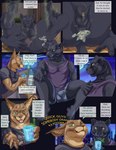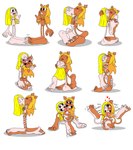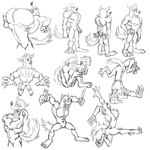
flexing toes
Dorsiflexion of the digits on a character's hindpaws, more commonly referred to as flexing toes. It is the complementary inverse movement to plantarflexion or curling_toes. It can be observed as a natural part of locomotion (i.e. walking, running, jogging) in a character's gait as their paws push off the ground to propel them forward. It is also a common byproduct of sexual arousal generated by the parasympathetic autonomic nervous system (also known as the "feed-and-breed" response).
Mammalian copulation
Toe dorsiflexion is also a well-known aspect of copulation in many mammals due to the archetypal positioning that requires a mating pair to maintain their balance while the male's thrusting imparts an intermittent lateral force. While this naturally causes toe dorsiflexion to occur, the behavior also occurs independent of such a need. Prolonged stimulation to the genitals has been observed to produce a long‐lasting (>1 minute) contraction of the triceps surae muscles in both sexes of several species of mammalian quadrupeds, suggesting a genital–hind limb muscle relationship mediated by the pudendal nerve.1
See also
Notes
1 The pudendal nerve is responsible for registering sensation from the external genitalia of both sexes and the adjacent skin, as well as the motor supply to various pelvic muscles, including the external urethral and anal sphincters.


